How to Speed Up an Old Mac Without Upgrading Hardware
Don’t replace your old Mac yet! Learn how to make it run faster with simple software optimizations and keep it running smoothly, with bonus tips to maintain your old Mac for long-term performance.
Modern Macs are incredible computers, but over time, you may notice that your Mac doesn’t run as fast as it used to. Storage drives fill up, apps start to lag, and your Mac seems a little bit slower every time it starts up.
Apple has a very rapid hardware update cycle, which actively pushes you to buy the latest and greatest model. They even have specific official names for older Mac hardware to hurry things along: 5-year-old ‘vintage’ Macs receive limited hardware support and OS updates, while 7-year-old ‘obsolete’ Macs are no longer supported in any way.
Fortunately, you don’t have to buy a new Mac just because Apple wants you to! In this guide, our iMobie team will show you 10 easy ways to speed up your old Mac without upgrading hardware.
These tips will work for any Mac, including MacBook Pro, MacBook Air, iMac, and other Mac models. Let’s get started!
Why Do Old Macs Slow Down?
Even if you don’t count hardware problems, several other issues can cause an older Mac to slow down over time. The good news is that these issues can be fixed without spending a dime!
| Cause/Reason | Probability | Impact | Fix Difficulty |
| Low storage space | 80% | 8/10 | 3/10 |
| Too many resource-heavy apps running | 60% | 8/10 | 5/10 |
| Too many background processes running | 50% | 7/10 | 6/10 |
| Thermal throttling caused by dust buildup | 50% | 8/10 | 1/10 |
| Too many startup items | 40% | 7/10 | 2/10 |
| Outdated software | 30% | 6/10 | 2/10 |
| Unoptimized macOS settings | 20% | 6/10 | 1/10 |
10 Ways to Speed Up an Old Mac Without Upgrading Hardware
Quick Method: Using CleanMyMac for efficiency (Recommended)
If you’re in a rush to get your Mac back to full strength, CleanMyMac offers a simple, all-in-one solution to your performance problems. It helps free up storage space, safely removes large or unwanted applications, identifies duplicate files, manages startup items, clears out old files left behind by previous app uninstallations, and much more.
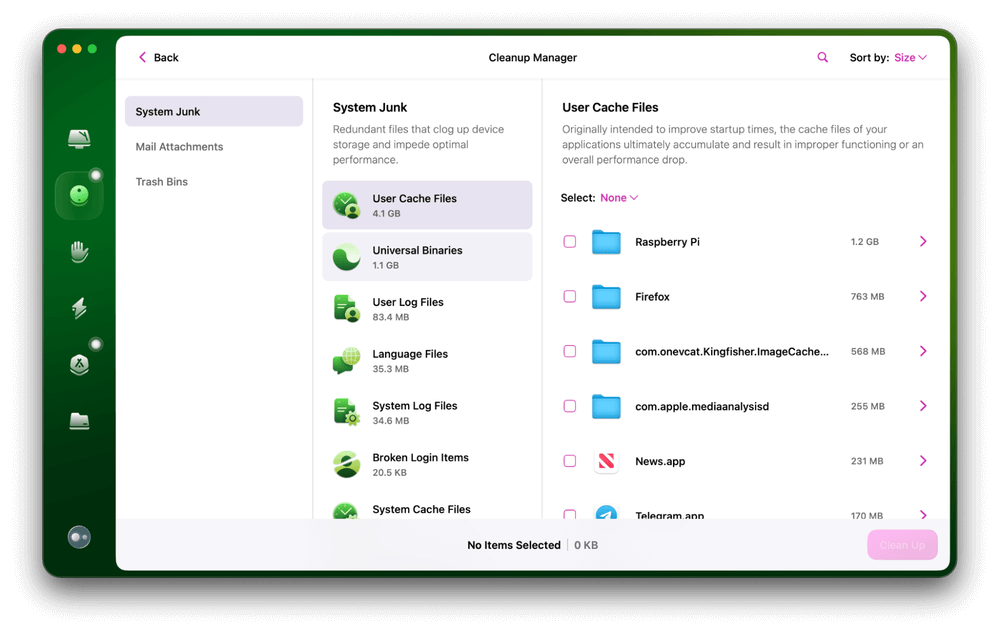
CleanMyMac Cleanup Manager module
The most significant advantage of CleanMyMac is simplicity, as it centralizes a lot of helpful performance fixes in one place for easy management. You can accomplish all the same tasks by hand, but it takes time and effort that you may prefer to spend on something else.
Method 1: Dust Removal
| Time Needed | Difficulty Level | Impact on Result |
| 5-10 minutes | Easy | Medium |
Over time, ordinary household dust can build up on fan intakes and even inside your Mac’s case, which may cause the components to overheat. To prevent damage, your Mac can reduce its speed to reduce the amount of heat generated by the CPU, known as ‘thermal throttling.’
Fortunately, this issue has a simple fix: use a vacuum cleaner or a clean, dry microfiber cloth to remove any accumulated dust or debris on the fan intakes.
If your Mac has a case that can be opened without special tools, power it down completely, open it, and gently use a vacuum to remove any dust that has built up inside. Be careful not to touch any of the components directly!
This video has more:

Method 2: Free Up Storage Space
| Time Needed | Difficulty Level | Impact on Result |
| 5-10 minutes | Easy | High |
Storage drives work best when they have some free disk space available. Most experts and manufacturers recommend between 10% and 20% free space, so aim for 10% at the minimum.

macOS Storage Overview
- Open the Apple menu and click System Settings.
- Switch to the General section, then select the Storage subsection.
- macOS will provide a quick overview of what’s using space on your drive so you know which areas to work on.
Click the small i icon next to each entry in the list to see more details and helpful tools for removing large files and old downloads.
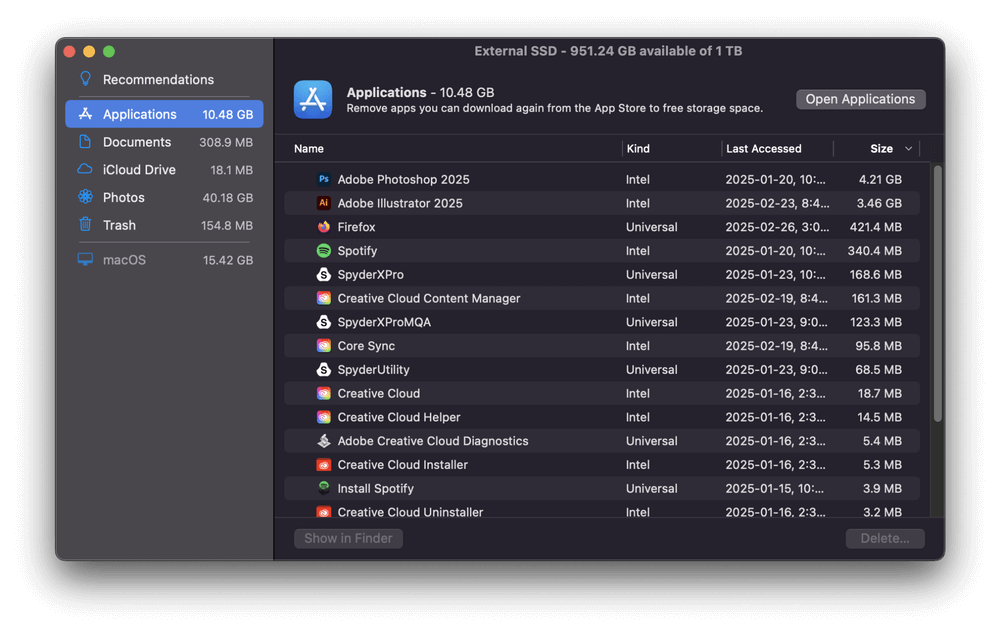
macOS Storage Applications Overview
Note: Older macOS versions have a similar tool in the Storage tab of the ‘About This Mac’ feature, as shown above.
Method 3: Manage Startup Items
| Time Needed | Difficulty Level | Impact on Result |
| 5-10 minutes | Easy | High |
Startup items launch every time your Mac boots up, and running too many at once can slow down Mac startup and turn it into a snooze-fest. They’re easy to control once you know how:
- Open the Apple menu, click System Settings.
- Navigate to the General section. Click Login Items & Extensions and the items listed in the Open at Login section.
- To remove an item, simply select it and click the small minus button below the list.
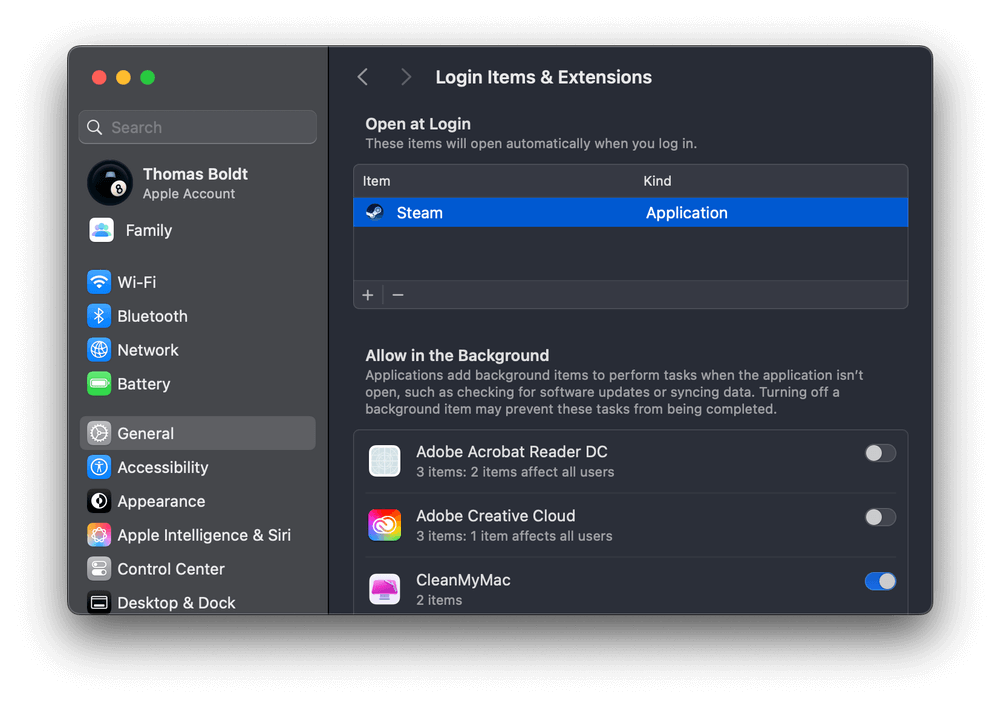
macOS Login Items & Extensions
On older macOS versions, open the Users & Groups section of your System Preferences, then select your user account and switch to the Login Items section, as shown below.
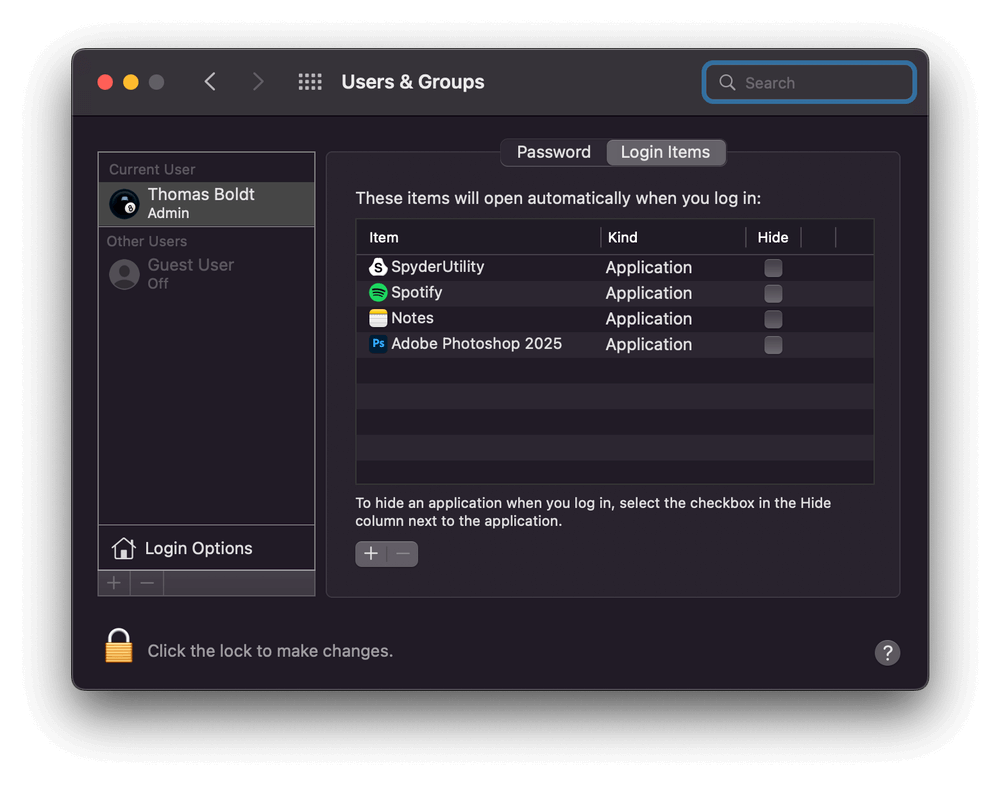
macOS Users & Groups
That’s all there is to it!
Method 4: Close Resource-Heavy Apps
| Time Needed | Difficulty Level | Impact on Result |
| 5-10 minutes | Easy | High |
Some apps take up more system resources than others, but it’s not always easy to tell which apps are draining your performance. Here’s how you can check:
Use the Command + Space keyboard shortcut to open Spotlight search, and type Activity Monitor to locate the app. Activity Monitor shows you everything your Mac is doing and what resources are used.
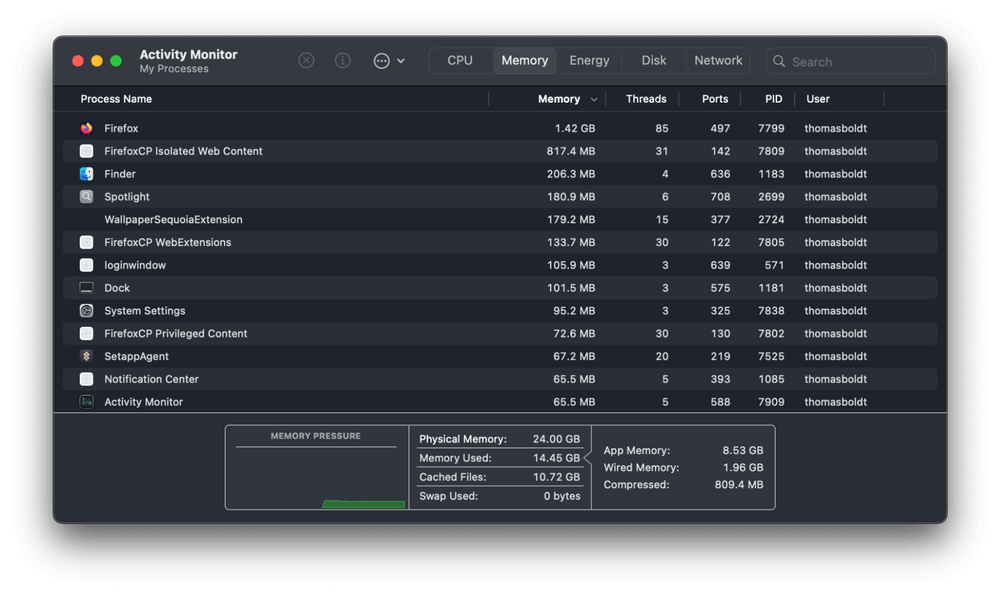
macOS Activity Monitor Overview
Switch between the CPU, Memory, and Disk sections to identify resource-heavy apps. Select an item in the list, and click the Stop button at the top of the window to close it.
Just make sure you only close known apps you are running because closing the wrong process could crash your Mac!
Method 5: Uninstalling Unused Applications
| Time Needed | Difficulty Level | Impact on Result |
| 5-10 minutes | Easy | Low |
Unused applications can still take up storage space and run background processes, which might slow down your Mac.
Here’s a quick way to locate unused apps:
- Open the Apple menu, click System Preferences / Settings, and switch to the General section.
- Open the Storage subsection, then click the small i icon next to Applications to see a list of all apps installed on your Mac.
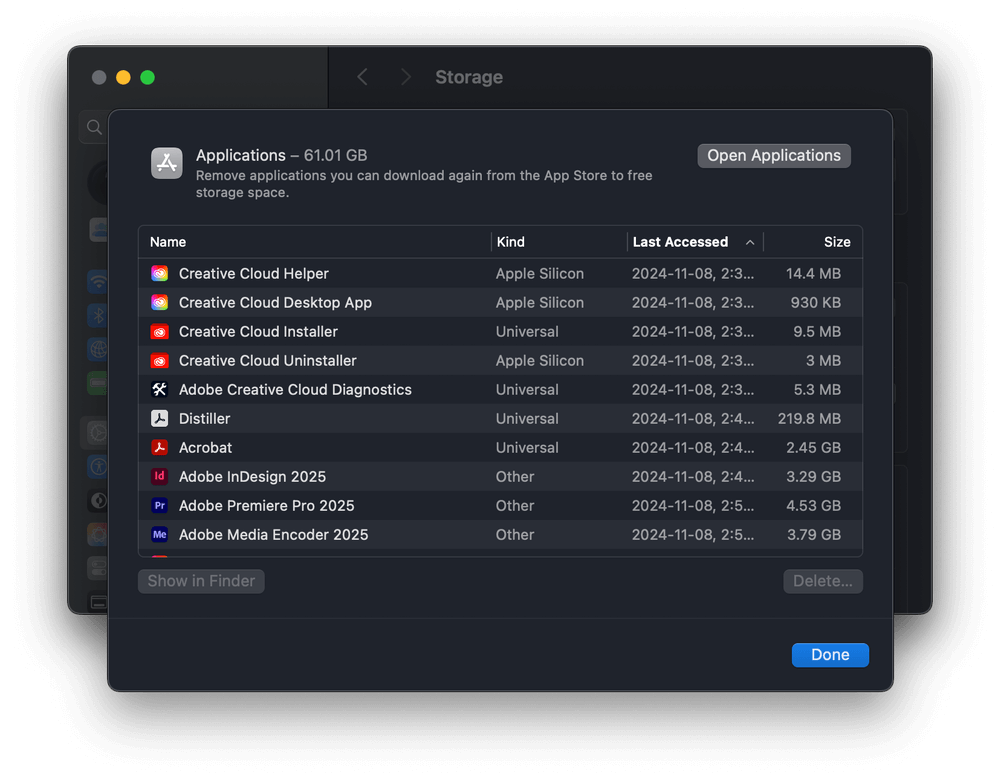
macOS Storage installed applications
Note: Older macOS versions have a similar tool in the Storage tab of the ‘About This Mac’ feature.
At the top of the list, click the Last Accessed column header to sort the list by usage date (click it again to switch the sort order). This will help you identify which apps are no longer being used, even if you’ve forgotten about them! Select an item from the list, and click Delete to uninstall it from your Mac.
Method 6: Clear Desktop Clutter
| Time Needed | Difficulty Level | Impact on Result |
| 5-10 minutes | Easy | Low |
macOS does a lot of work behind the scenes to keep your files constantly up-to-date when they are displayed, and because the desktop is continually being displayed, too many files can slow things down.
This won’t be an issue for most people, but if you have hundreds or thousands of items on your desktop, you may experience performance issues.
The simplest way to deal with this problem is to move your desktop clutter to a separate folder, such as the Documents folder. It’s almost as easy to access in Finder, but your Mac won’t constantly monitor all those files once they’re off the desktop.
Method 7: Optimize macOS Settings for Speed
| Time Needed | Difficulty Level | Impact on Result |
| 5 minutes | Easy | High |
Macs have a lot of energy management tricks, usually designed to help increase laptop battery life. However, longer battery life also means slower performance – it’s an inescapable balancing act.
- Open your system settings and switch to the Battery section.
- Locate the Energy Mode section, and adjust your On battery and On power adapter settings.
- To ensure you get maximum performance, set each option to High Power.
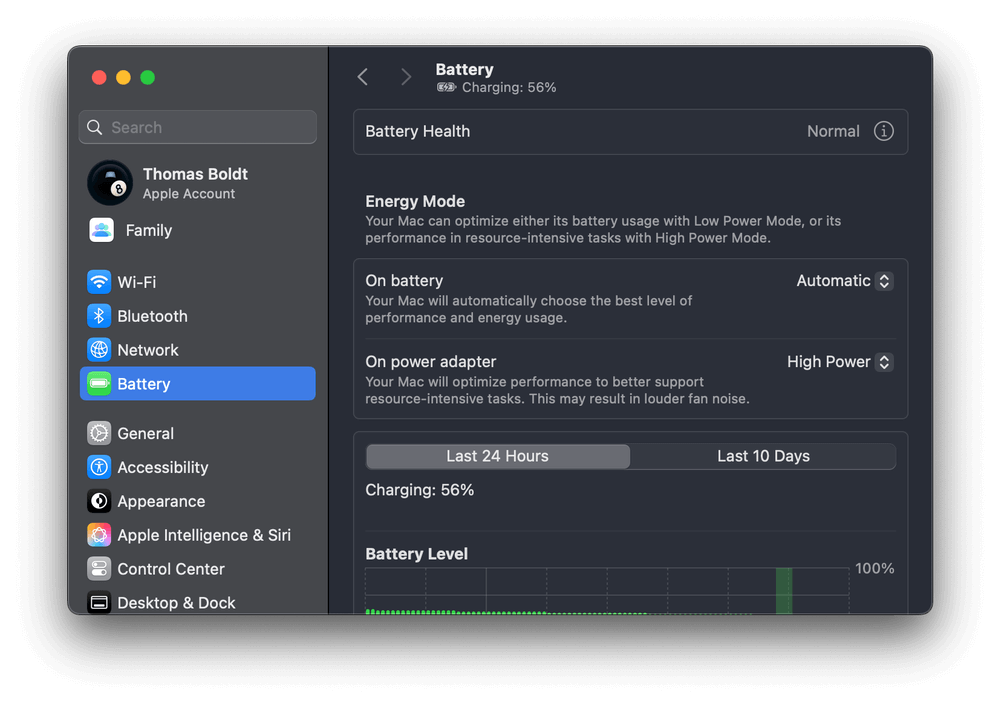
macOS Battery settings
Just be aware that you may have to charge your battery more often or stay plugged in!
Method 8: Update macOS and Apps
| Time Needed | Difficulty Level | Impact on Result |
| 45-60+ minutes | Easy | Medium |
One of the simplest ways to ensure your Mac is running its best is by keeping your software up-to-date. New software releases usually include bug fixes and performance improvements.
Open your Mac’s system preferences and locate the Software Update section to check for macOS updates. You can also launch the App Store to check for updates to your apps or visit the developer’s official website for more information on third-party apps.
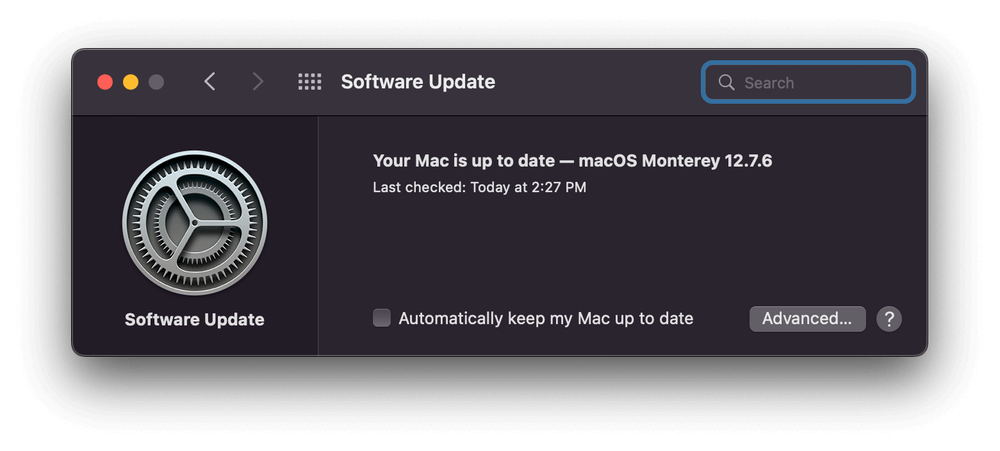
macOS Software Update
Alternatively, you can use CleanMyMac to manage your macOS and app updates in less time!
Method 9: Disable Spotlight Indexing (Temporarily)
| Time Needed | Difficulty Level | Impact on Result |
| 5 minutes | Medium | High |
Spotlight search maintains an up-to-date index of every file on your Mac. Normally, this is useful, but if you’re copying a lot of new files to your Mac or connecting large external drives, you might experience slowdowns as Spotlight updates its index.
Here’s how to turn it off:
- Open your System Settings and switch to the Spotlight section.
- Switch to the Search Privacy tab and click the + button at the bottom of the list to prevent Spotlight from indexing specific locations.
- You can add a particular folder that you’re using or an entire external drive.

macOS Spotlight Search Privacy
Don’t forget to remove the Privacy exception when you’re finished, or your files will not appear in Spotlight!
Bonus Tips to Maintain Your Old Mac for Long-term Performance
Here are a few other tips you can use on a daily basis to improve your Mac’s performance.
1) Regularly restart your Mac
Restarting your Mac clears several caches and removes some temporary files. It will also close any crashed or poorly-coded apps that may be sitting unnoticed in the background, hogging resources.
2) Avoid running too many apps simultaneously
Running multiple apps at once can be great for productivity, but taking it too far can slow down your entire computer. When apps compete for your Mac’s processor power and memory, macOS will try to divide its limited resources to run everything at once instead of focusing on your most important app.
3) Use lightweight alternatives to resource-heavy apps
Sometimes, the most powerful software tool isn’t the best choice for the job. For example, there’s no need to use Photoshop to resize images when macOS Preview can do the same job with fewer system resources.
4) Use Safe Mode to clear caches and check for system issues (for advanced users)
Safe Mode is a special boot mode that runs the bare minimum of software required to boot your Mac: no login items, no third-party extensions, only the macOS basics. It also clears the font and kernel caches, which can sometimes cause issues.
- On Intel-based Macs, hold down the Shift key while your computer boots up.
- On M-Series Macs, power your computer down completely, then press and hold the power or TouchID button until you see the Loading Startup Options message. Select your startup drive, then hold down the Shift key and click Continue in Safe Mode.
FAQs
How long does a Mac usually last before I consider buying a new one?
You should start considering your options after 5 years. Apple typically provides 5 years of active support for Mac computers, but once they’re 7 years old, they will no longer receive any support. This can leave your Mac vulnerable to security threats and prevent you from running the latest apps. If you don’t care about those aspects, you can keep using your Mac until it stops working!
Can I speed up my old Mac without spending money?
Yes, you can speed up your old Mac without spending money, but you’ll have to dedicate some time to learning the technical details of how it all works. Think of it like any other machine: if you know how to maintain it yourself, you can keep it running at its best without spending any money.
Why is my old Mac so slow after updating macOS?
Newer versions of macOS usually include fancy new features designed for the latest Mac hardware, which can cause older Macs to struggle. System updates may also cause Spotlight to reindex your storage drive, which can cause slowdowns on older mechanical platter-based drives.
How often should I clean up my Mac?
If you use your Mac heavily, constantly working with lots of files and installing/uninstalling new apps, then you may benefit from cleaning up your Mac every week. If you’re just using your Mac to check email and browse the web, you may never need to clean it up.
Final Words
By combining these 14 tips and tricks, you can breathe new life into your old Mac without spending money on hardware upgrades. If you’re willing to spend the time and effort required to learn a bit more about macOS, you can save yourself thousands of dollars by delaying or even avoiding the purchase of an expensive new Mac!
Product-related questions? Contact Our Support Team to Get Quick Solution >
